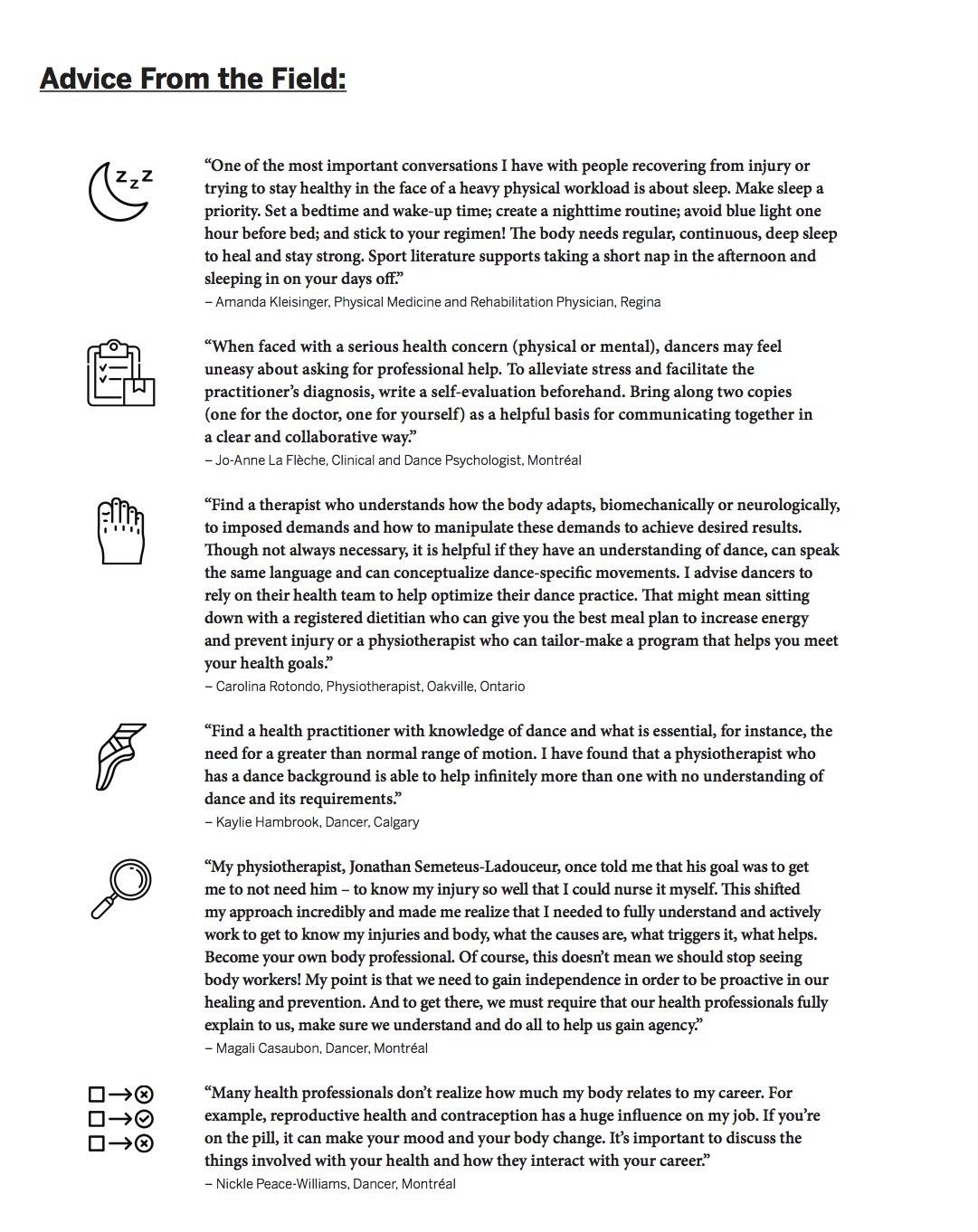Communicating with health-care professionals and dealing with health concerns can be challenging for anyone. This interaction can pose specific challenges for many dancers, who may hesitate to seek help for their health concerns, fearing the counsel they receive will lack an understanding of their lives and practice. Familiar advice, such as “Don’t do that movement” or “You’ll have to take time off” and “A few visits to the massage therapist will help,” can seem frustrating to a dancer who lacks the necessary time and funds to comply.
Dance as a profession does not commonly provide job stability. Practitioners who fail to acknowledge this reality can leave a dancer feeling stressed and unsatisfied with an appointment. The reality is that independent dance artists may lose contracts if they take time off or cease to do movements that are essential to a piece of choreography. Furthermore, these dancers are unlikely to receive paid sick leave or be able to afford the services of allied health professionals. Even a dancer with a contract that does provide paid leave for illness, injury or personal reasons may hesitate to take time off for fear of losing a valued role. In such cases, a well-meaning sick note or requisition can feel unhelpful, and seemingly practical counsel may go unheeded by the dancer. These types of dancer-doctor interactions may result in the dancer resisting further help.
Because dance is a physically demanding practice and profession, dancers are necessarily in tune with their bodies. They must also monitor their mental and emotional health because dancing can provide psychological and social challenges. For these reasons, dancers benefit from working with practitioners who recognize these factors and work collaboratively with them to find solutions. The following tips can help dancers communicate effectively with health-care professionals and make the most of their appointments:
-
Find a practitioner who has experience working with dancers. Ask teachers and peers to recommend someone they have found helpful, or consult the Healthy Dancer Canada (HDC) Directory to see if there is a health-care professional in your area who has a special interest in dancers. Practitioners with knowledge of dance tend to understand the many demands and challenges that dancers face. They’re also more likely to acknowledge and utilize a dancer’s embodied knowledge and kinesthetic sensitivity when diagnosing and treating health concerns.
-
Prepare for your appointment. Once you’ve found a practitioner and set an appointment date, have the following ready in order to optimize your appointment time:
-
A list of your symptoms and questions. Brief appointments may not allow you to get through all of your concerns, so list them in order of priority. What are your symptoms? For how long have you experienced them, and how often? What worsens and improves these symptoms?
-
A list of your medications and dosages. Include the prescription medications, over-the-counter medications and supplements that you take.
-
The name and contact information of anyone who should receive a copy of your report, such as your general practitioner.
-
HDC Communication Form (healthydancercanada.org/open-dance-resources) – a form that facilitates communication amongst the dancer, teacher/rehearsal director and health professional and helps to build a team approach to managing dancers’ health concerns.
-
-
Take a patient advocate to your appointment if necessary. If you are afraid to speak up for yourself, are too ill or need support for emotional, cultural or any other reasons, bring a trusted family member or friend with you. An advocate can help explain your situation and concerns, take notes, ask questions and help you understand the information and advice you receive. Consider using the Manitoba Institute for Patient Safety’s Patient Advocate Agreement (mips.ca/assets/mips_patient_advocate_agreement_eng_fill.pdf) to determine how your advocate can best support you.
-
Describe your symptoms accurately, and be honest about your reality and intentions. You know your body and what is normal for you. Describe how you generally feel and function physically, mentally and emotionally and how things have changed. Demonstrate problematic movement if that is part of your health concern. Explain the realities of your dance practice and your life. Be honest if you know you cannot follow the practitioner’s advice fully (or at all). For instance, if a problematic movement is part of choreography you will be doing, let the practitioner know that while you can avoid the movement during classes, you cannot avoid it while performing. Then ask for guidance to navigate the situation and strive for collaborative solutions.
-
Understand your diagnosis and treatment plan. If you are uncertain about your diagnosis or doubtful that you can follow a health practitioner’s counsel, ask for more information. Request clarification and/or inquire about other treatments available to you. Be sure you understand what specific tests will show, what benefits and potential side-effects you may experience with any prescribed medications or treatments and how these things will affect your dance practice. If you are still not confident about the diagnosis and/or treatment, find another provider and get a second opinion. Do not give up – your health and well-being are important!
-
Adhere to your treatment plan. Once you have a diagnosis and treatment plan that will ultimately help, rather than unnecessarily hinder you, take this information back to your teachers and rehearsal directors so they know what modifications to your practice are required and for how long (see HDC’s resource page for additional documents). Along with the support from your advocate, this discussion can help you adhere to your treatment plan.
Andrea Downie is the director of EnhanceDance, a founding member and immediate past president of Healthy Dancer Canada and the guest faculty artist-in-residence in the dance program at University of Calgary.
Amber Downie-Back is a dancer, a choreographer and the co-director of the pilot project Murphy Dance Company, operating out of Montréal. She is a recent graduate of Concordia University’s contemporary dance program.

Tagged: All, Healthy Dancer, All





